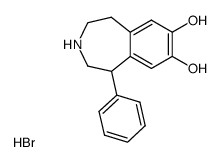20012-10-6
| Name | 7,8-Dihydroxy-1-phenyl-2,3,4,5-tetrahydro-1H-3-benzazepine Hydrobromide |
|---|---|
| Synonyms |
SKF 38393 hydrobromide
(±)-SKF 38393 hydrobromide SKF 38393 (±)-1-phenyl-2,3,4,5-tetrahydro-(1H)-3-benzazepine-7,8-diol hydrobromide (+/-)-1-phenyl-2,3,4,5-tetrahydro-(1H)-3-benzazepine-7,8-diol hydrobromide 7,8-dihydroxy-1-phenyl-2,3,4,5-tetrahydro-1H-3-benzazepine hydrobromide (+)-Muscarine iodide |
| Description | SKF 38393 hydrobromide is a selective agonist of the dopamine D1 receptor (D1DR) with an IC50 of 110 nM[1]. |
|---|---|
| Related Catalog | |
| Target |
D1 Receptor:110 nM (IC50) |
| In Vitro | SKF 38393 hydrobromide induces a similar change in cytomorphology and increases the levels of media cAMP[2]. SKF-38393 hydrochloride (10 μM; 1 hour) induces increased threonine-phosphorylation of DA- and cAMP-regulated phosphoprotein of Mr 32 kD (DARPP-32) in cultured GC cells[2]. Western Blot Analysis[2] Cell Line: GC cells Concentration: 10 μM Incubation Time: 1 hour Result: Induced increased threonine-phosphorylation of DA- and cAMP-regulated phosphoprotein of Mr 32 kD (DARPP-32) in cultured GC cells. |
| In Vivo | SKF 38393 hydrobromide (10 mg/kg; i.p.) blocks the 1-Methyl-4-phenyl-1,2,3,6-tetrahydropyridine (MPTP) -induced depletion of glutathione[3]. SKF 38393 hydrobromide attenuates MPTP-induced depletion of dopamine[3]. SKF 38393 hydrobromide enhances the activity of superoxide dismutase and hence mimics the action of Selegiline[3]. SKF 38393 hydrobromide enhances the frequency but not the amplitude of tetrodotoxin-resistant excitatory postsynaptic currents which argues for a presynaptic locus of D1 action[4]. Animal Model: Balb/c mice (20-25 g)[3] Dosage: 5 mg/kg, 10 mg/kg Administration: Intraperitoneal injection Result: Blocked the MPTP-induced depletion of glutathione and attenuated MPTP-induced depletion of dopamine. |
| References |
| Molecular Formula | C16H18BrNO2 |
|---|---|
| Molecular Weight | 336.22400 |
| Exact Mass | 335.05200 |
| PSA | 52.49000 |
| LogP | 3.66230 |
